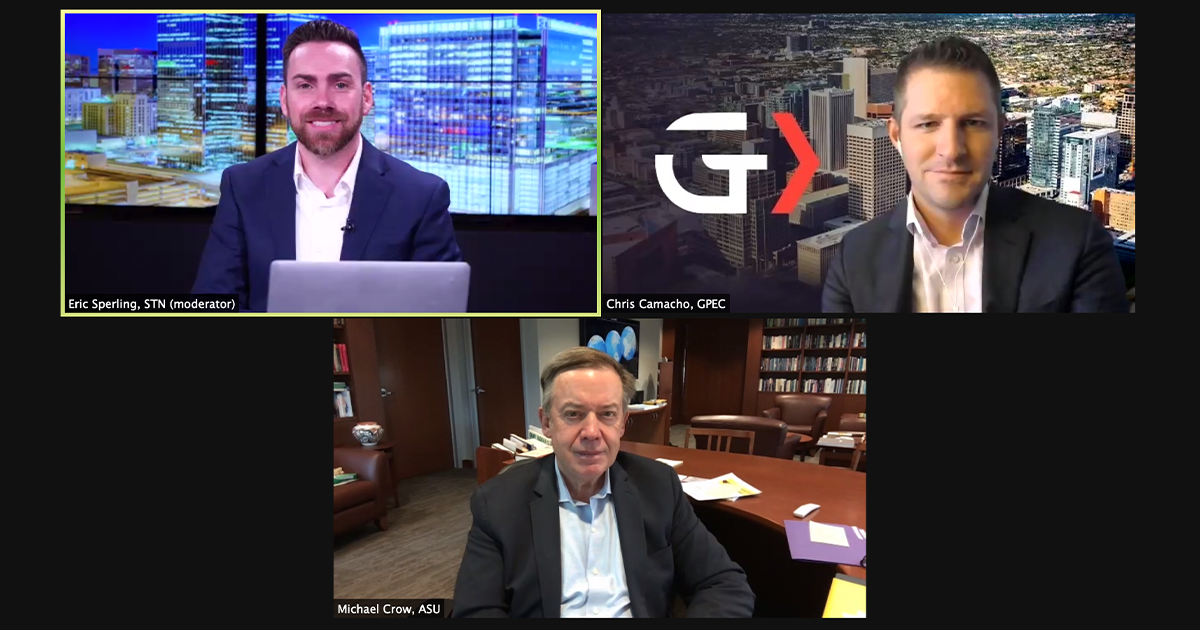

Regional Report: New Economy Initiative
Published: 12/17/2020
Arizona’s water projects that began in the early 20th century cost billions of dollars. They revolutionized the state by expanding not only the way industries could operate, but how people could live and has yielded returns far exceeding that initial investment.
This is the type of perspective toward investment needed for the New Economy Initiative, a model to stimulate the economy into the digital age with advancements in emerging technology and science sectors, Arizona State University President Dr. Michael Crow said when he joined GPEC President & CEO Chris Camacho for a Regional Report on Thursday.
“That’s the size of the economy that has emerged from relatively small public infrastructure investments,” Crow said.
Further investment from private and public leaders is necessary to help accelerate the state into the future as a national and world leader, Crow said.
What will be the next project that launches Arizona ahead?
“The industries of the future are other things that spin out of already (existing industries),” Crow said. “…We need to grow industries that don’t exist.”
There are five key industries that he believes Arizona can be at the forefront in advancement:
- Future communications technologies: “Motorola has been here in the past. Their spinouts and the companies that grew out of Motorola are still here, but future communication technologies will be involved in every single thing we do.”
- Extreme environment tech: “Phoenix and Arizona should become the center for managing all things related to global climate change … we’ve got to now worry about mitigation and response and adaptation. I read the other day that there were scientists that had developed a material that you could put on the outside of a building, which would then, using the chemistry of the material itself and protons from the sun, cool the building. No more air conditioners. No more heat exhausts being put into the climate.”
- Human performance: “We’ve already got unbelievable sports activities and sports teams, we’ve got fantastic medical and healthcare organizations … How do you now build all of the industries around human performance, advanced clothing, advanced wearables, advanced computation, advanced health outcomes? We have a little bit of that, so we think that’s the third sector.”
- Energy and materials: “How will we build an economy driven by nothing but the photons from the sun, the water in the air and on the ground, and carbon dioxide, which is already existing in the atmosphere? It turns out you can build an entire economy from that. Arizona should be the center of this economy. They should be the place in which every new technological development commercialized is coming out of.”
- Advanced manufacturing: “Something that we’ve learned during COVID is that manufacturing … doesn’t have to be concentrated only in a TSMC-type plant … All of the thousands and thousands and thousands of component parts that go into that manufacturing process, a lot of those could be made in people’s homes with advanced manufacturing networks, advanced 3D printing technologies, advanced ways of thinking about doing manufacturing and distributed formats.”
“We have to find a way to bring the entirety of Arizona’s population — all families, all backgrounds, all family histories, all family incomes — at least to the average of American educational attainment,” Crow said. “If we cannot do that, we will not be competitive.”
This takes commitment. This takes money. This takes a willingness to keep pressing forward, for perhaps decades of work, the way other cities have done.
“I firmly believe that the region and ultimately the state needs a vision in all of these areas that we’re committed to, but work to execute against not just in a political cycle, but over a 20-year period, 30-year period,” Camacho said. “That’s what it’s going to require for us to make these commitments that transcend people like me and ultimately Michael.”
To stay competitive, markets must evolve and advance. Greater Phoenix is no different. The region has long had an advantage and now it’s time to take it to the next level by evaluating and implementing a progressive and innovative approach to our future.
As the fastest-growing market in the country, Greater Phoenix has the population ready to fill the gaps and innovate; with education and training to meet the needs of industries of tomorrow, we can get there. But in order to do this, it takes leadership across the public and private sector to take a stand, commit to a plan and not get sidetracked when the plan takes decades. The Central Arizona Project, which created the 336-mile canal system, was first agreed upon in 1968 and wasn’t complete for 25 years but changed the foundation of the state. That is the type of timeline such an endeavor may take.
Arizona has found economic stability. The economy is taking huge strides forward, but as a young market, intentional investments from the public and private sectors are necessary to ensure long-term growth and success as competition increases.